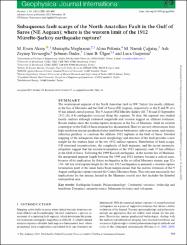| dc.contributor.author | Aksoy, M. Ersen | |
| dc.contributor.author | Meghraoui, Mustapha | |
| dc.contributor.author | Polonia, Alina | |
| dc.contributor.author | Çaǧatay, M. Namık | |
| dc.contributor.author | Yavuzoǧlu, Aslı Zeynep | |
| dc.contributor.author | Önder, Şebnem | |
| dc.contributor.author | Ülgen, Umut B. | |
| dc.contributor.author | Gasperini, Luca | |
| dc.date.accessioned | 2022-12-13T12:21:53Z | |
| dc.date.available | 2022-12-13T12:21:53Z | |
| dc.date.issued | 2022 | en_US |
| dc.identifier.citation | Aksoy, Murat Et Al. "Subaqueous fault scarps of the North Anatolian Fault in the Gulf of Saros (NE Aegean); where is the western limit of the 1912 Mürefte-Şarköy earthquake rupture?," Geophysical Journal International , vol.1, no.1, 1-39, 2021. | en_US |
| dc.identifier.issn | 0956540X | |
| dc.identifier.uri | https://doi.org/10.1093/gji/ggab462 | |
| dc.identifier.uri | https://hdl.handle.net/20.500.12809/10438 | |
| dc.description.abstract | The westernmost segment of the North Anatolian fault in NW Turkey lies mostly offshore, in the Sea of Marmara and the Gulf of Saros (NE Aegean), respectively to the E and W of a 45 km inland central portion. The 9 August 1912 Mürefte-Åžarköy (Ms 7.4) and 13 September 1912 (Ms 6.8) earthquakes occurred along this segment. To date, the segment was studied mostly onshore although estimated magnitude and location suggest an offshore extension. Recent studies show the eastern rupture extension in the Sea of Marmara, while its western counterpart in the Gulf of Saros remains less documented. Here we use new observations from high-resolution marine geophysical data (multibeam bathymetry, side-scan-sonar, and seismic reflection profiles), to constrain the offshore 1912 ruptures in the Gulf of Saros. Detailed mapping of the subaqueous fine-scale morphology and structure of the fault provides a new insight for the western limit of the two 1912 surface ruptures. Distribution of fresh scarps, 3-D structural reconstructions, the complexity of fault segments, and the recent seismicity, altogether suggest that the western termination of the 1912 rupture(s) ends 37 km offshore in the Gulf of Saros. Following the 1999 Kocaeli earthquake, in the eastern Sea of Marmara, the unruptured segment length between the 1999 and 1912 ruptures became a critical issue, because of its implication for future earthquakes in the so-called Marmara seismic gap. If a 150-160 km total rupture length for the two 1912 earthquakes is assumed, a western rupture termination point at the inner Saros basin margin means that the eastern extension of the 9 August earthquake rupture reached the Central Marmara Basin. This outcome necessarily has implications for the seismic hazard in the Marmara coastal area that includes the Istanbul metropolitan area. | en_US |
| dc.item-language.iso | eng | en_US |
| dc.publisher | Oxford University Press | en_US |
| dc.relation.isversionof | 10.1093/gji/ggab462 | en_US |
| dc.item-rights | info:eu-repo/semantics/openAccess | en_US |
| dc.subject | Continental tectonics | en_US |
| dc.subject | Strike-slip and transform | en_US |
| dc.subject | Dynamics | en_US |
| dc.subject | Seismotectonics | en_US |
| dc.subject | Earthquake hazards | en_US |
| dc.title | Subaqueous fault scarps of the North Anatolian Fault in the Gulf of Saros (NE Aegean); where is the western limit of the 1912 Mürefte-Åžarköy earthquake rupture? | en_US |
| dc.item-type | article | en_US |
| dc.contributor.department | MÜ, Mühendislik Fakültesi, Jeoloji Mühendisliği Bölümü | en_US |
| dc.contributor.authorID | 0000-0002-7778-2018 | en_US |
| dc.contributor.institutionauthor | Aksoy, M. Ersen | |
| dc.identifier.volume | 229 | en_US |
| dc.identifier.issue | 1 | en_US |
| dc.identifier.startpage | 589 | en_US |
| dc.identifier.endpage | 604 | en_US |
| dc.relation.journal | Geophysical Journal International | en_US |
| dc.relation.publicationcategory | Makale - Uluslararası Hakemli Dergi - Kurum Öğretim Elemanı | en_US |


















